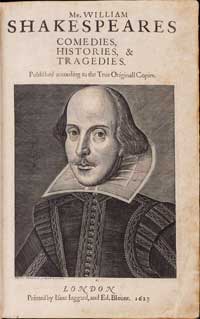 William Shakespeare
William Shakespeare23 April 1564, 8:30am*
Stratford-Upon-Avon, England
Placidus Houses, True Node
Geocentric, Tropical
*Baptism (Source Notes)
William Shakespeare, engraving by Martin Droeshout
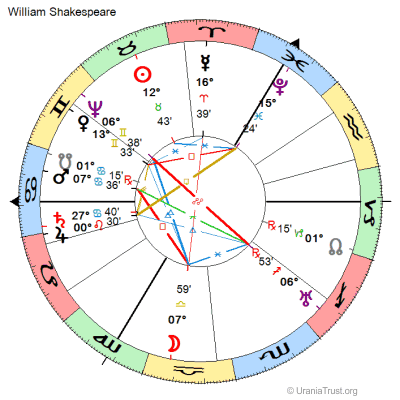
In Astrology and Shakespeare, Part I, I argued that astrological symbolism shows up in Shakespeare’s works not only as single references but also as the archetypal basis for entire plays, as, for example, in Romeo and Juliet. Shakespeare’s familiarity with these symbols is clearly due to more than just acquaintance with the almanacs and calendars common in his time. Part of the profundity of his work is that he references the greater cosmological model that includes specific astrological details, a model originating in ancient times. Certain of his characters explicitly voice the philosophy behind it; one of those is Ulysses in Troilus and Cressida:
The heavens themselves, the planets and this centre
Observe degree, priority and place,
Insisture, course, proportion, season, form,
Office and custom, in all line of order:
And therefore is the glorious planet Sol
In noble eminence enthron'd and sphere'd
Amidst the other . . . (I, iii, 85 & ff)
Rooted in the philosophy of the Neo-Platonists of the first centuries B.C.E. and C.E., principally in Alexandria, Egypt, this world view goes back to Plato (5th and 4th c. B.C.E.), likely earlier still to Pythagoras (6th c. B.C.E.), and possibly even earlier to the Egyptians and Mesopotamians.
We know little about Pythagoras since only six fragments of his writings have survived the vicissitudes of time and history. However, an important idea of his has persisted and shows up clearly in Shakespeare: the heavens are ordered and produce a harmony of sound called the “music of the spheres”. This idea may reference the mythic Orpheus, who was thought to create such harmonious music on his seven-stringed lyre that it could bring the dead to life. The lyre’s seven strings undoubtedly represented the planets. One example that refers to this idea in Shakespeare’s oeuvre is Lorenzo’s exquisite speech to Jessica at the end of The Merchant of Venice:
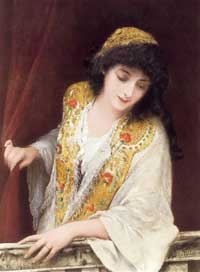 Jessica in The Merchant of Venice, by Samuel Lake, 1888
Jessica in The Merchant of Venice, by Samuel Lake, 1888How sweet the moonlight sleeps upon this bank!
Here will we sit and let the sounds of music
Creep in our ears.
. . . Look how the floor of heaven
Is thick inlaid with patines of bright gold.
There's not the smallest orb which thou behold'st
But in his motion like an angel sings,
Still quiring to the young-ey'd cherubins.
Such harmony is in immortal souls;
But whilst this muddy vesture of decay
Doth grossly close it in, we cannot hear it.
(V, I, 54-6, 58-65)
The thinkers who most likely influence Shakespeare, though, are the later Neo-Platonists. They take many of Plato’s ideas and elaborate, reinterpret, and modify them. Plotinus (205-270 CE), the most prominent Neo-Platonist, and his followers developed a cosmology based on the concept that the Universe was One: a single, intelligent, and animate organism. Creation happens through an unfolding of differentiated levels of being out of the Divine in an integrated hierarchical structure so closely linked that it was called "the Great Chain of Being". Like a cascading series of waterfalls, each dimension unfolds out of the one above.
An important corollary of the idea of a linked chain of creation is that there are unseen and often subtle correspondences between different levels of this One Being. The Universe is unified by hidden affinities or resonant bonds of sympathy between these rungs of the ladder of creation (an apt metaphor because some believe that the soul not only descends from the heavens through the planetary spheres to be born, but can also ascend while still embodied through intense spiritual practices, or can do so later after death).
The idea of this “secret sympathy” is a possible conceptual basis for astrology, reflected in the phrase "as above, so below". Analogous parts on different levels are recognizable because they might have the same color, or the same function, or be the recognized individualized expression of a fundamental archetype or first principle. Consequently the Sun, the metal gold, the lion as king of the jungle, the heart within the body and the king within the body politic are interchangeable because they have the same rank within their separate spheres of creation. Thus something in one level of the hierarchy can substitute for another in a different level since they are equivalent. Shakespeare uses these associations frequently in his plays. Here’s an example from Richard II:
See, see, King Richard doth himself appear,
As doth the blushing discontented sun
From out the fiery portal of the east . . .
York adds
Yet looks he like a king! Behold, his eye,
As bright as is the eagle’s, lightens forth
Controlling majesty. (III, iii, 62-4, 68-70)
So king = sun = east = light--all associations that would be immediately grasped by Shakespeare’s audience.
How might these ideas have seeped into Renaissance thinking? In particular, how did they get into England by the late fifteenth century?
We can trace the ebb and flow of this philosophical and mystical worldview from Pythagoras to Plato, to the Neo-Platonists like Plotinus. After that, it migrates to the Middle East while Europe sinks into the period of political and social breakdown known as the Dark Ages. Baghdad, for example, is a brilliant centre of learning, peaking between the 800's and 1200's.
This Neo-Platonist view resurfaces in Europe through several paths: in Spain during the 1100's (called "the 12th century Renaissance") when Arab writings begin to be translated into Latin and the West starts recovering Plato; in Florence in the mid-1400's when scholars fleeing the fall of Constantinople to the Turks in 1453 brought manuscripts with them and Cosimo de Medici instructed his astrologer-physician Marsilio Ficino to drop everything and translate the newly-appeared writings attributed to the ancient sage Hermes Trismegistus; and in various parts of Europe after the expulsion of the Jews from Spain in 1492.
It is impossible to overstate the importance of a confluence of (a) the wealthy Medici family in Florence in the 1400’s who support learning and the arts, (b) a brilliant thinker like Ficino (whom Nicholas Campion calls “the greatest intellect of the 15th-c. Renaissance” in A History of Western Astrology, Vol. 2: The Medieval and Modern Worlds, p. 95), and (c) a culture exhausted by scholastic sterility of thought and hair-splitting. Ficino’s translations, especially of Plato’s works, revitalize European thought. Nature is again seen as permeated by divinity, human beings as noble—potentially divine—creatures, and the smaller human world as a reflection of the greater cosmos. In short, the microcosm replicates the macrocosm, and can potentially reflect its glory. European thought rediscovers the ancient paradigm of an integrated cosmos.
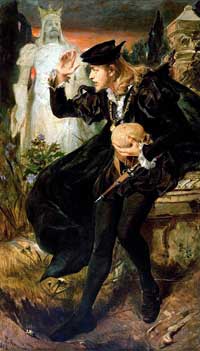 Hamlet's Vision, painted by Pedro Américo
Hamlet's Vision, painted by Pedro AméricoWe hear this enthusiastic vision of the makeup of the universe and the possibilities of the fully realized human being in the ruminations of Hamlet:
. . . this goodly frame, the earth . . . this most excellent canopy, the air, look you, this brave o’erhanging [firmament] this majestical roof fretted with golden fire . . . What a piece of work is a man! How noble in reason! How infinite in faculty, in form and moving! How express and admirable in action! How like an angel in apprehension! How like a god! The beauty of the world! The paragon of animals! (II, ii, 309-19)
Another important figure associated with Ficino in the brilliant circle around the Medici court is Giovanni Pico della Mirandola (1463-94) who synthesizes Jewish mysticism or Cabala (dispersed into Europe with the Jewish diaspora from Spain) with Hermetic philosophy to create Christian Cabala and writes the celebrated Oration on the Dignity of Man in which he declares humankind free and capable of self-transformation.
Another contributor to this tradition around the same period is Francesco Giorgi (or Zorzi) of Venice (1466-1540), a Franciscan who publishes a work entitled De harmonia mundi (1525), which connects angelic hierarchies and planetary spheres, emphasizing number as a key to understanding the various levels.
This world view migrates north and appears in works by Johannes Reuchlin (1455-1522), one of the great scholars of the German Renaissance, who as a young man travelled in Italy and met Pico and his circle of learned men. He even quotes Pico in his first Cabalist work De verbo mirifico (1494). Reuchlin has an enormous influence on such minds as Erasmus and Martin Luther, and his writings set the philosophical tone of the Reformation.
During the 1500's and after, it was common for English gentlemen to do the "Grand Tour" of Europe, often for years, and reside for long periods in several countries--especially Italy. During these travels, they could certainly have encountered some of these ideas. Important figures in this tradition also reverse this trend, and visit England. One of these is the famous Henry Cornelius Agrippa (1486-1535), the brilliant son of minor nobility who had served Austrian royalty for generations. Agrippa was a precocious learner, and was the talk of his town when as a child he insisted on speaking only Latin. Deeply interested in esoteric studies, he completed a three-volume work De occulta philosophia at the astonishing age of 23. This work is now considered the most important esoteric compendium of the past 500 years.
Agrippa’s great accomplishment is to synthesize Greek and Roman occultism drawn from classical sources with the recent philosophizing of Ficino and Pico. Essentially he is blending Neoplatonism with Jewish mysticism. Agrippa travels widely--and here’s the significant point: he is in England around 1510 just after Henry VIII ascends the throne. Somehow Shakespeare is exposed to Agrippa’s great work, since Prospero’s magical talents in Shakespeare’s The Tempest reflect his influence (as shown in Frank Kermode’s introduction to the 1954 Arden edition of that play).
Agrippa is not the only eccentric figure to visit England and bring rediscovered ideas with him. Another is Giordano Bruno (1548-1600). Deeply influenced by Agrippa, he quotes directly from him in one of his own works. Bruno’s visit to England comes during Shakespeare’s own lifetime, in the 1580s. A passionate (and argumentative) supporter of Copernicus’ heliocentric theories, Bruno also influences English writers. Dame Frances Yates credits him with inspiring the group around Sir Philip Sidney (to whom Bruno dedicates two works) and giving some impetus to the Elizabethan poetic Renaissance.
What about the English? Aren’t there intelligent Englishmen who know about this philosophical worldview in the late 1500’s and who could have influenced the culture and perhaps indirectly, Shakespeare? Yes, there are two. One is another notable traveller to Europe, the famous Dr. John Dee (1527-1608) (likely the particular model for Prospero in The Tempest).
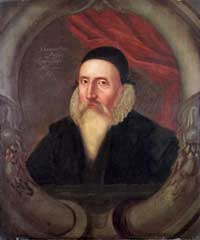 John Dee, artist unknown
John Dee, artist unknownDee is at that time a respected philosopher and mathematician (he gave lectures on Euclid at the University of Paris in 1550 and later worked this into a much-praised preface to the English translation of Euclid in 1570). He is a proponent of scientific studies, such as geography and navigation (he travelled to the Low Countries to study navigation with Gemma Frisius, one of the most prominent geographers of the age, and became friends with the renowned mapmaker Gerard Mercator; consequently, he is consulted by many of the English nobles planning expeditions to the New World). He is also a lifelong enthusiast of the fine arts (especially music, architecture, painting, and drama).
Dee is often at the English court of Elizabeth I. Apparently her personal astrologer, he elects the time of her coronation. We know Dee espouses the philosophic view described earlier because he quotes Pico on number and has books by Pico, Reuchlin, Giorgi, and Agrippa in his library. In fact, Dee's library is the finest in 16th-century England and his home and library are a magnet for the educated intellectuals of his day. After Bruno comes to Oxford to debate with the professors there (who are incensed at his championing of Copernicus’ heliocentric model of the solar system), Bruno visits Dee at his home in Mortlake, not far from Oxford along the Thames River.
But Dee is not the only Englishman who is a proponent of the ancient and Renaissance philosophical worldview. The second is Robert Fludd (1574-1637), one of the last “renaissance men”, interested in everything in all the worlds; he was a physician, astrologer, teacher and encyclopedic author, well versed in music, mathematics, and engineering, and designed machinery for masques at the Stuart court. Frances Yates even speculates that Fludd used the physical Globe theatre as the framework for his version of the classical “Art of Memory” system, by which all learning could be categorized and recalled.
It is tempting to wonder whether Dee, Fludd and Shakespeare ever connected . . .
Dee returns from his stay in Europe in 1589, and is in England until his death in 1608, during Shakespeare’s most productive period. Fludd receives degrees at Oxford—just down the Thames from Dee’s home--from 1591 through 1598. Whether contact with either of these two men exposed Shakespeare to this spiritual philosophy or via some other route, it is precisely the comprehensive nature of this paradigm, one that incorporates cosmic, mundane, and nature symbolism in a unified artistic whole, that gives his plays their universal appeal. Twist the tales however you will—transpose Romeo and Juliet to gang-ridden New York City, or combine Roman, Elizabethan and Victorian costume in a single production, or set A Midsummer Night’s Dream in the Caribbean—they seem untouched for they retain their archetypal consistency, which reveals itself through astrological symbolism. We continue to enjoy and appreciate them, perhaps even more so as we explore their hidden correspondences.
Read Astrology and Shakespeare, Part 1
Priscilla Costello
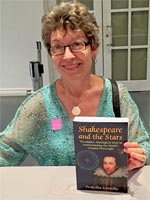
Priscilla Costello, M.A., Dipl. CAAE, is a counseling astrologer, teacher and writer with a professional astrological practice spanning over 30 years. Teaching English also for over 30 years has given her a deep appreciation of Shakespeare, as well as the opportunity to synthesize the literary and the astrological. Founder and Director of The New Alexandria, a centre for religious, spiritual, and esoteric studies, she is the author of The Weiser Concise Guide to Practical Astrology (2008), a unique introduction to astrology linking it to psychology, religion, and esoteric wisdom. She is currently working on Shakespeare and the Stars, a book expanding her exploration of Shakespeare’s familiarity with esoteric wisdom.
Bibliography
Campion, Nick - A History of Western Astrology, Vol. II, The Medieval and Modern Worlds
Costello, Priscilla - The Weiser Concise Guide to Practical Astrology
de Vore, Nicholas - Encyclopedia of Astrology
Ferguson, Kitty - The Music of Pythagoras : How an Ancient Brotherhood Cracked the Code of the Universe and Lit the Path from Antiquity to Outer Space
French, Peter J. - John Dee: The World of an Elizabethan Magus
Godwin, Joscelyn - Robert Fludd: Hermetic Philosopher and Surveyor of Two Worlds
Kermode, Frank, ed. - The Tempest. Arden ed.
Tarnas, Richard - Cosmos & Psyche: An Intimation of a New World View
Tarnas, Richard - The Passion of the Western Mind
Tillyard, E. M. W. - The Elizabethan World Picture
Yates, Frances A. - The Art of Memory
Yates, Frances A. - Giordano Bruno and the Hermetic Tradition
Yates, Frances A. - The Occult Philosophy in the Elizabethan Age
